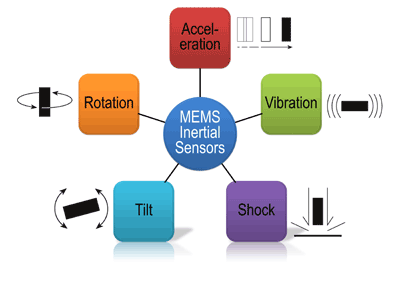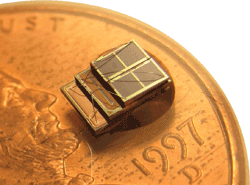Improving control with MEMS inertial sensors
BY BOB SCANNELL, MEMS/Sensors Technology Group, Analog Devices
www.analog.com
Recent sensor technology developments are enabling revolutionary improvements in robotics and other industrial system designs. In addition to robotics, applications where inertial sensors can potentially improve system performance or functionality include platform stabilization, motion control for industrial machinery, security/surveillance devices, and industrial vehicle navigation. The motion information provided by such sensors can be invaluable in improving not only performance, but also reliability, safety, and cost of ownership. More… http://www.nxtbook.com/nxtbooks/hearst/projectmems_201106/index.php?startid=5

Inertial sensors today are capable of detecting a variety of motion types.
Packaging faces a ‘perfect storm’: Electronic device packaging is changing rapidly
BY RICHARD COMERFORD, Editor, Electronic Products
www2.electronicproducts.com
In many ways, it’s a “perfect storm” — a situation in which a set of factors combine to create your worst nightmare. In electronic design, those factors have been coming together for the last decade until, now, we are at the point where industry must change course dramatically to avoid disaster. This new direction requires that designers rethink the way devices are assembled and encapsulated if they are to meet the requirements for the next generation of not only consumer goods, but of many military and industrial applications as well. More… http://www.nxtbook.com/nxtbooks/hearst/projectmems_201106/index.php?startid=11

In this wireless identification and sensing platform (WISP) node developed at the University of Michigan’s Wireless Integrated Microsystems Laboratory (WIMS), solar cells (top layer) and a battery (bottom layer) are wire bonded to the middle layer, which has a processor, SRAM, and a PMU.
Integrating MEMS with DSPs /microprocessors
BY KAREN LIGHTMAN, MEMS Industry Group,
Pittsburgh, PA
www.memsindustrygroup.org
MEMS (microelectromechanical systems) can help us to both sense the world around us and to actuate movement based on the information we gather. Motion control in applications such as the Nintendo Wii remote, the Apple iPhone, automotive airbags, and electronic stability control systems are just a few examples of MEMS in real-world applications. More…
http://www.nxtbook.com/nxtbooks/hearst/projectmems_201106/index.php?startid=16

Processors can be used for backend processing when merged with inertial and other system sensors in a Kalman filter. (Photo courtesy of Analog Devices.)
MEMS and Moore’s Law
Since 1965, the semiconductor industry has marched to the beat of Moore’s Law, which in effect states that the number of transistors in a given area of silicon will double every two years. Said another way, the area of silicon needed to contain a given transistorized function will decrease by half every two years. Many have questioned whether Moore’s Law will continue to hold true for CMOS electronics, and whether it will hold for MEMS devices as well.
Recently, Akustica (www.akustica.com) introduced a new fully integrated MEMS microphone that it says is not only the smallest microphone, but also the smallest MEMS device of any kind. The accompanying image shows how much Akustica’s MEMS microphones have decreased in size since the first one was introduced in 2005. The 80% shrinkage in six years, while it falls slightly short of Moore’s Law, is till impressive and to be applauded. The industry is moving in the direction of complying with the law.
In an article in MEMS Investor Journal , Shahin Farshchi, Senior Associate, Lux Capital Management, LLC, makes another point about MEMS and Moore’s Law. He notes that MEMS-dependent devices like micromachined resonators, mechanical transistors, spin-based memories, silicon photonics, and silicon-based millimeter-wave transceiver techniques can actually reduce circuit complexity and allow increased functionality without transistor shrinkage.
So when it comes to fighting to keep Moore’s Law alive, MEMS may be the proverbial double-edged sword that cuts both ways.
Richard Comerford
For more information on Project MEMS, visit www.electronicproducts.com/projectmems
Advertisement
Learn more about Digi-Key





